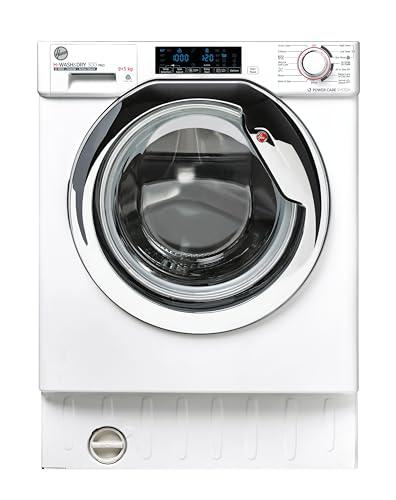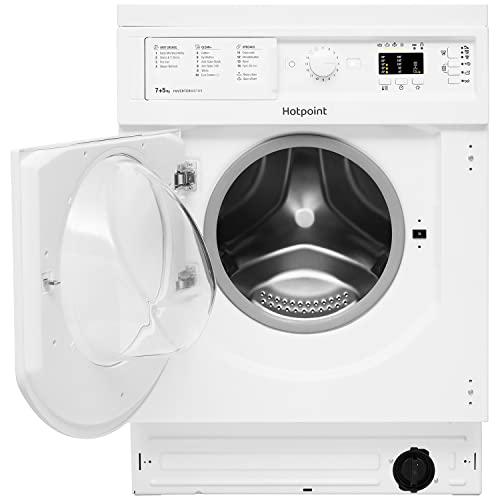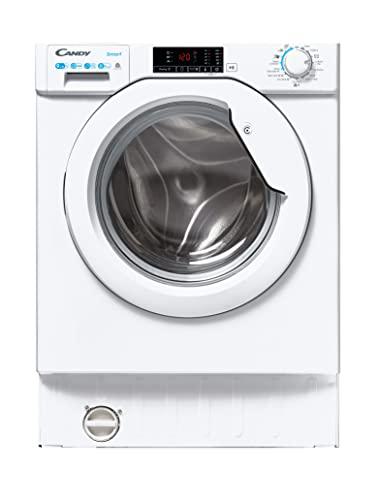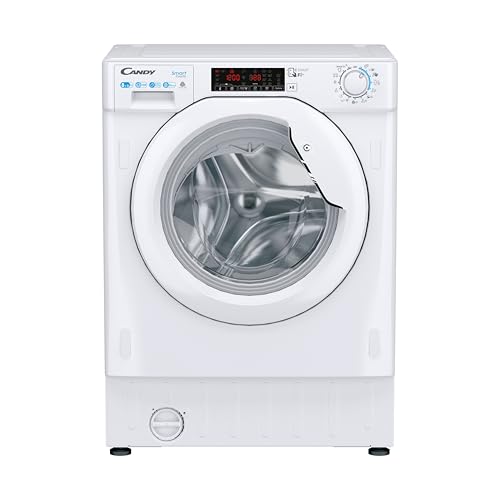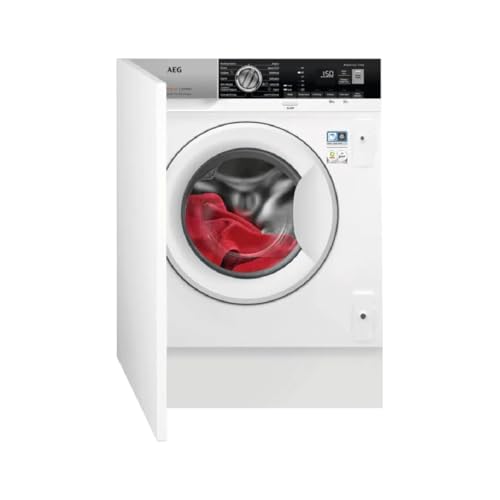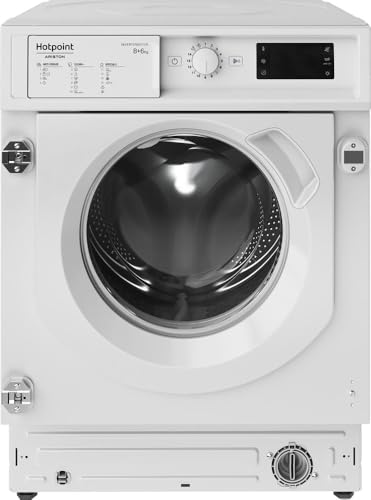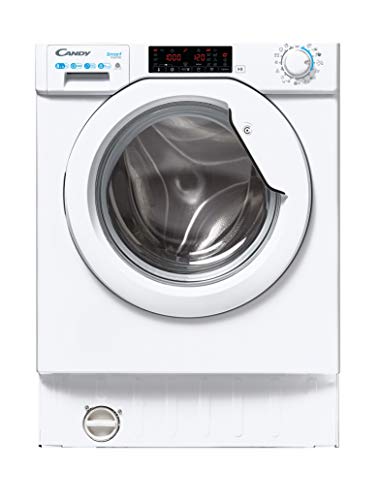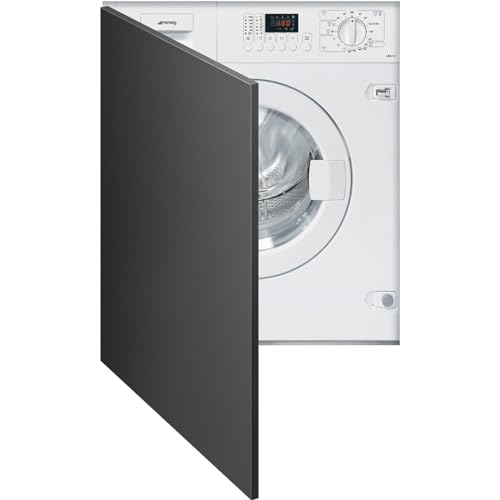Are built-in washer-dryers good?
Built-in washer-dryers have an average overall score of 6.8 and an average user rating of 7. Free-standing washer-dryers have an average overall score of 7.4 and a user rating of 7.9.
The best built-in washer-dryers (with the highest overall score) are as follows.
- Hoover H-WASH&DRY 300 PRO HBDOS 695TAMCE-80 (Overall score: 7.32 points)
- Hotpoint BI WDHG 75148UKN (Overall score: 7.04 points)
- Whirlpool BI WDWG 961485 EU (Overall score: 6.81 points)
Note: Products currently available are listed first.
What are the main advantages of built-in washer-dryers?
Built-in washer-dryers have the following advantages over free-standing washer-dryers:
- Lower energy consumption per 100 combined cycles: Built-in washer-dryers use 307 kWh, which is 15 kWh less than free-standing washer-dryers (322 kWh)
- Lower water consumption per combined cycle: Built-in washer-dryers use 72 litres, which is 8 litres less than free-standing washer-dryers (80 litres)
- Higher maximum spin speed: Most built-in washer-dryers reach 1400 RPM or more
- Equal purchase price: Built-in washer-dryers cost about £550, same as free-standing washer-dryers
- More specialised programs: Many built-in washer-dryers include programs like Wool, Gentle, Outdoor/Sport, Jeans, Shirt and Baby care
- More additional functions: Built-in washer-dryers include Prewash function, Anti-stain function, Steam function, Extra Rinse function, Anti-crease function, Fast cycle option, Water+ option, Night/Silent option and Power Save mode
- More built-in features: Almost all built-in washer-dryers include a laundry detection system, automatic drying, delay start option and selectable drying level
- Lighter weight: Built-in washer-dryers weigh on average 65 kg, which is 4 kg less than free-standing washer-dryers (69 kg)
- Smaller space requirement: Built-in washer-dryers take up 0.26 m³, which is roughly 15% less than free-standing washer-dryers (0.30 m³)
What are the main disadvantages of built-in washer-dryers?
Built-in washer-dryers have the following disadvantages compared to free-standing washer-dryers:
- Smaller drum volume on average: Built-in washer-dryers have an average drum volume of 52 L, while free-standing washer-dryers have 63 L.
- Limited spin speed range: Only about 50% of built-in washer-dryers can reach the minimum spin speed of 400 RPM.
- Fewer models with self-cleaning cycle: Only around 28% of built-in washer-dryers include a Self-cleaning cycle, while 79% of free-standing washer-dryers have this feature.
- Fewer available cycles: Some cycles are less common in built-in washer-dryers than in free-standing washer-dryers (e.g. Refresh, Hygiene, Colors, Allergen, Duvet).
- Longer ECO combined cycle: The ECO combined cycle takes on average 550 min in built-in washer-dryers, which is 65 min longer than in free-standing washer-dryers (485 min).
- Lower share of inverter motor: About 72% of built-in washer-dryers include an inverter motor, compared to 92% in free-standing washer-dryers.
- Fewer features for delicate clothes and convenience: Only around 22% of built-in washer-dryers include a special drum design for delicate clothes, and only a few include noise-reducing design. No built-in models include an interior light or reversible door.
- Limited smart features: Only a few built-in washer-dryers include Wi-Fi, NFC, or Smart Diagnosis. None include Automatic dosing system, Automatic drawer cleaning, Eco Indicator, or AI Technology.
Which brands make the best built-in washer-dryers?
The best built-in washer-dryer brands (with the highest overall score) are as follows.
- Hotpoint (Average overall score: 7.1 )
- Hoover (Average overall score: 7 )
- Candy (Average overall score: 6.9 )
Which built-in washer-dryers brands have the highest user ratings?
How much do built-in washer-dryers cost?
Built-in washer-dryers usually cost from about £410 up to £1,020, with an average price of around £550. This average matches the typical price of free-standing washer-dryers.
You can expect built-in washer-dryers to sit within this price range regardless of brand or model, so you won’t pay more just because the machine integrates into your kitchen furniture. The £550 average reflects standard features and performance levels across most brands.
The following chart shows the price distribution for built-in washer-dryers.
[vertical-chart-20360520524519693]
What should you consider while choosing the best built-in washer-dryers?
When choosing the best built-in washer-dryers, focus on washing and drying capacity, drum volume, dimensions, energy consumption, motor type, and features. Check the washing and drying load size to match your laundry needs. A larger drum helps clothes move better during cycles and improves efficiency. Measure your space carefully, since built-in models must fit standard cabinet sizes. Look at the energy rating to manage electricity use and long-term costs. The motor type affects noise levels and durability—brushless motors usually last longer and run more quietly. Check the range of washing and drying programs, especially Quick wash, Eco modes, or cycles for specific fabrics. Look for practical features like delay timers, sensors, and easy-to-use controls.
What capacity do the built-in washer-dryers have?
Built-in washer-dryers have a washing capacity that ranges from 7 to 9 kg and a drying capacity that ranges from 4 to 6 kg. The most common combinations are 8/6 kg (about 28%), 7/4 kg (about 28%) and 8/5 kg (about 17%).
Drum volume in built-in washer-dryers ranges from 52 to 58 L. Most have a 52 L drum, which is 11 L less than the average drum size of free-standing washer-dryers (63 L).
Built-in washer-dryers take up between 0.26 and 0.28 m³ of space, and most models only take 0.26 m³. That is about 15% less than the average size of free-standing washer-dryers (0.30 m³).
Weight ranges from 63 to 82 kg, and most weigh about 65 kg, which is 4 kg lighter than the average free-standing washer-dryer (69 kg).
The capacity distribution for built-in washer-dryers is presented in the chart below.
[pie-chart-24489024146020666]
How energy-efficient are built-in washer-dryers?
Built-in washer-dryers are less energy-efficient than free-standing ones. Most built-in washer-dryers fall into lower energy efficiency classes for both washing and combined cycles.
For washing energy efficiency, only about 17% of built-in washer-dryers reach class A. Around 28% belong to class B, 11% to class C, 28% to class D and 17% to class E. Free-standing washer-dryers perform better, with about 54% reaching class A, 17% in class B, 18% in class C, 10% in class D and only 2% in class E.
In combined energy efficiency, built-in washer-dryers range from class B to class F. You will not find any models in classes A or C. Around 6% belong to class B, 33% to class D, 56% to class E and 6% to class F. Free-standing models again perform better, with less than 1% in class A, less than 1% in class B, 1% in class C, 42% in class D, 49% in class E and 3% in class F.
Built-in washer-dryers usually consume between 47 and 77 kWh per 100 washing cycles. The average is 66 kWh, which is higher than the 54 kWh average of free-standing models. For 100 combined cycles, built-in washer-dryers consume between 266 and 360 kWh, with an average of 307 kWh. This is slightly lower than the average 322 kWh for free-standing models.
Water consumption per washing cycle in built-in washer-dryers ranges from 44 to 50 litres, with an average of 46 litres. This is a bit less than the 48 litres average for free-standing washer-dryers. For combined cycles, water use ranges from 60 to 90 litres, with an average of 72 litres (8 litres less than the average 80 litres of free-standing models).
The chart below illustrates the distribution of washing energy efficiency classes across built-in washer-dryers.
[pie-chart-35816335537924808]
What is the spin efficiency of built-in washer-dryers?
The spin efficiency of built-in washer-dryers is usually either class A (around 0%) or class B (around 94%). Built-in washer-dryers generally have worse spin efficiency than free-standing models. In free-standing washer-dryers, 16% belong to class A, 83% to class B and less than 1% to class C.
Spin-drying efficiency class strongly depends on the machine’s maximum spin speed. About 89% of built-in washer-dryers reach 1400 RPM or higher. Around half of them also reach the minimum spin speed of 400 RPM, so you can wash delicate clothes that need gentle handling.
How loud are built-in washer-dryers?
Built-in washer-dryers are similar to free-standing washer-dryers in terms of noisiness.
You can expect the noise levels during different phases as follows:
- Spin noise level in built-in washer-dryers range from 70 to 78 dB: The average is 75 dB, same as free-standing washer-dryers
- Washing noise level in built-in washer-dryers usually range from 54 to 57 dB: The average is 56 dB, a bit more than free-standing washer-dryers that produce on average 54 dB
- Drying noise level in built-in washer-dryers usually range from 58 to 76 dB: Most have 58 dB, similar to free-standing washer-dryers
Noise emission classes in built-in washer-dryers usually range from class A to C. Around 39% belong to class A, around 39% to class B and around 22% to class C. These are similar to free-standing washer-dryers, where 40% vs 30% belong to class A, 30% vs 23% to class B, 23% vs 7% to class C and 7% to class D.
How many drying programs do built-in washer-dryers offer?
Built-in washer-dryers have usually 12–16 programs. On average, they have 14 programs, which is 1 more than the average of free-standing washer-dryers.
Most built-in washer-dryers include basic washing programs such as Eco 40-60, Cottons, Synthetics, Mix, and Wash&Dry.
Many also include the following specialized programs:
- Wool (in about 94% of products)
- Gentle (in about 72%)
- Outdoor/Sport (in about 44%)
- Jeans (in about 39%)
- Shirt (in about 22%)
- Baby care (in about 17%)
Some cycles appear less often in built-in washer-dryers than in free-standing ones:
- Refresh (in about 44% vs 78% of free-standing washer-dryers)
- Hygiene (in about 22% vs 50%)
- Colors (in about 17% vs 34%)
- Allergen (in about 11% vs 55%)
- Duvet (in about 6% vs 15%)
Only about 28% of built-in washer-dryers include a self-cleaning cycle (79% of free-standing models have it).
Washing Eco cycle in built-in models takes 170–230 minutes. Average time is 220 minutes, same as in free-standing models. Combined Eco cycle (Eco wash + cupboard drying level) takes 330–590 minutes in built-in washer-dryers. Average time is 550 minutes (65 minutes more than in free-standing washer-dryers, which take 485 minutes on average).
Which drying functions built-in washer-dryers have?
Built-in washer-dryers have several drying functions that improve performance and efficiency.
Many built-in washer-dryers include the following functions:
- Prewash function (about 61% of models)
- Anti-stain function (about 61%)
- Steam function (about 33%)
- Extra Rinse function (about 33%)
- Anti-crease function (about 33%)
- Fast cycle option (about 28%)
- Water+ option (about 22%)
- Night/Silent option (about 11%)
- Power Save mode (about 11%)
You won’t find built-in washer-dryers with a soak function, which is rare in general.
Built-in washer-dryers include from 7 to 14 advanced features. On average, they have 13 features, which is 2 less than free-standing washer-dryers.
Almost all built-in washer-dryers include a laundry detection system, automatic drying, delay start option and selectable drying level.
Other common features in built-in washer-dryers are as follows:
- Unbalanced load detection (~83%)
- Foam control system (~67%)
- Pause & Add feature (~72%)
- Automatic load balancing during spin (~56%)
- Selectable drying times (~50%)
- Favorite function (~28%)
- Acqua Stop (~22%)
- Pre-mix technology (~22%)
- Water Jets system (~22%)
Around 72% of built-in washer-dryers have an inverter motor (92% of free-standing washer-dryers have it).
Only around 22% have a special drum design for delicate clothes and just a few include a noise-reducing design. We have not found any built-in washer-dryer with interior light or reversible door.
Only a few built-in washer-dryer models include Wi-Fi connectivity, NFC connectivity or Smart diagnosis. We have not found built-in washer-dryers with Automatic dosing system, Automatic drawer cleaning, Eco Indicator or AI Technology.

